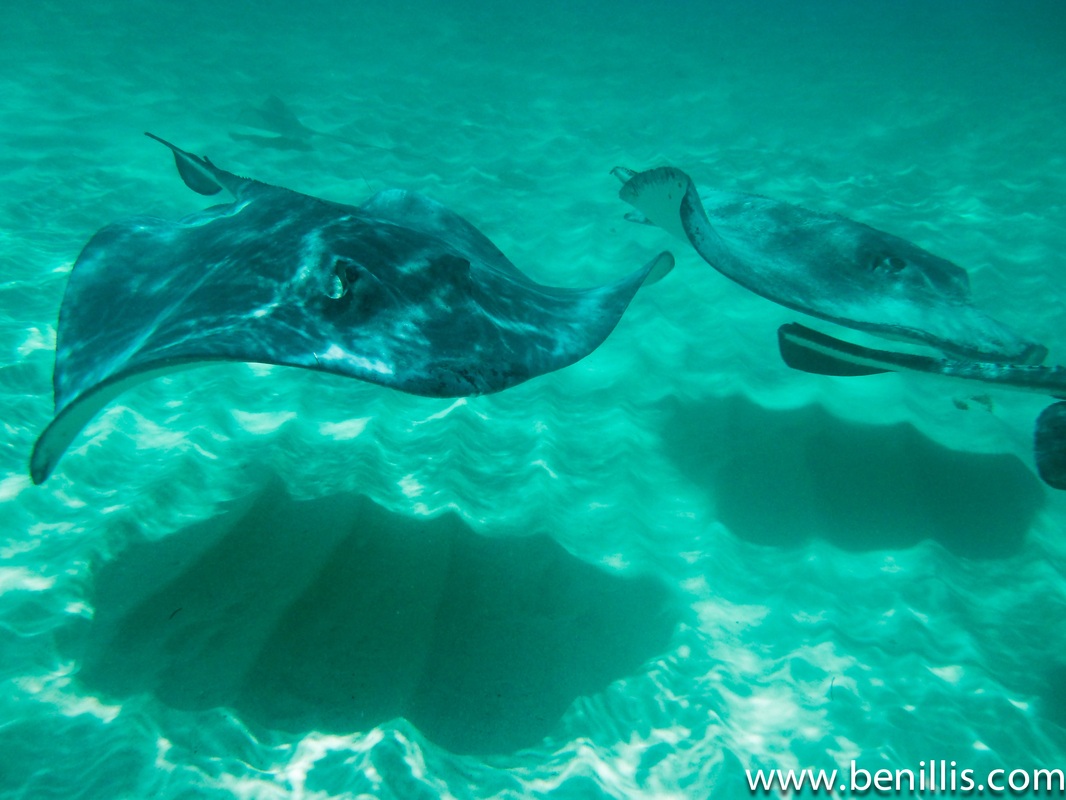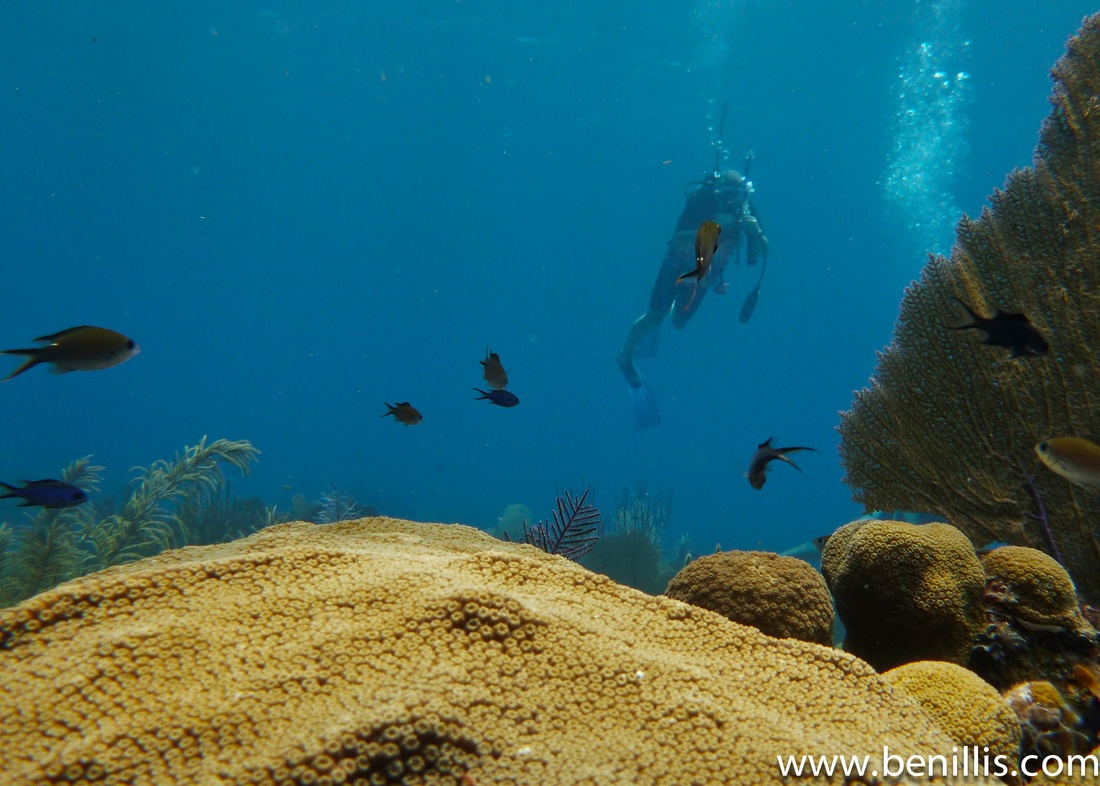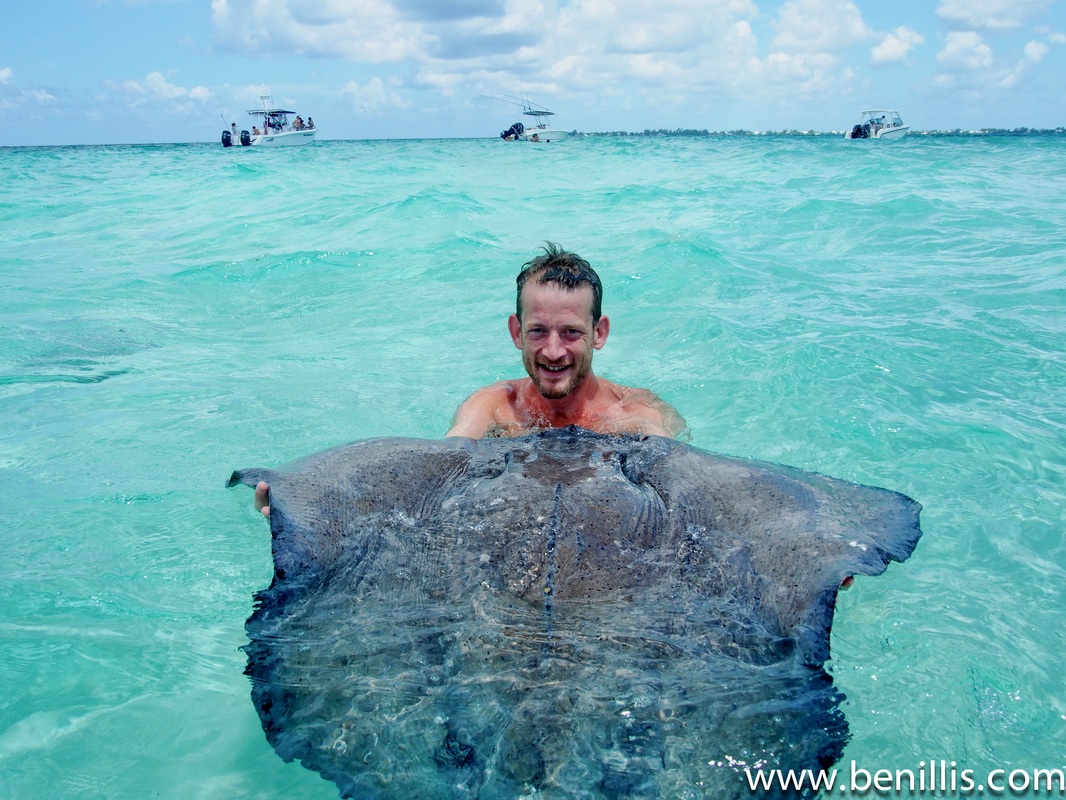News
The Cayman Islands: Above and Below
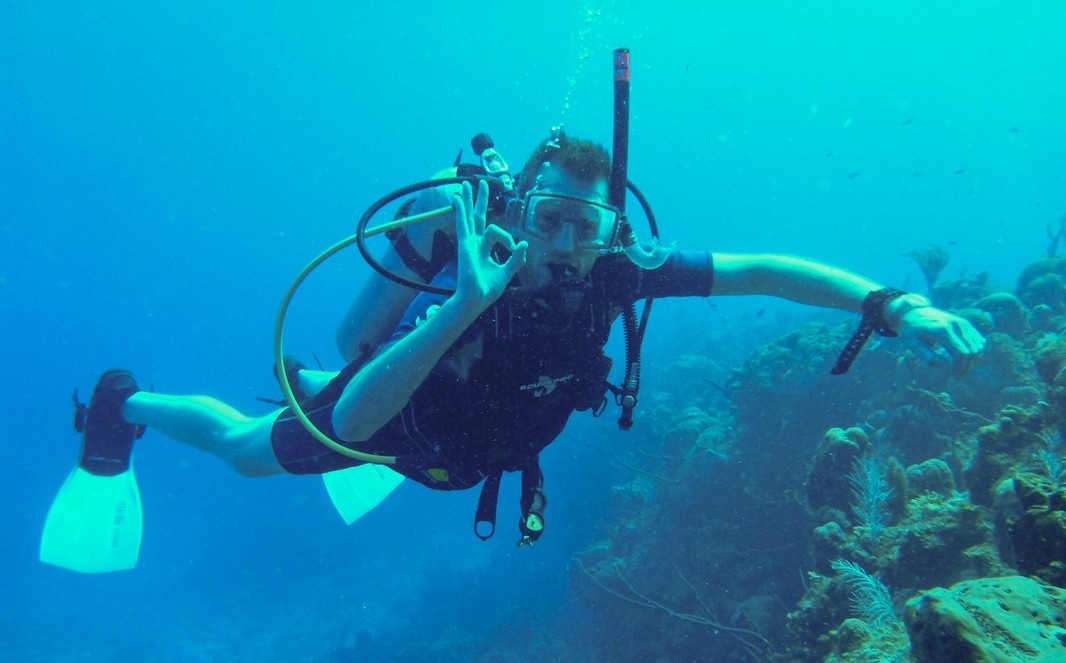
New diver Ben Illis visits the Cayman Islands to complete his open water course and to find out more about what the trio of Caribbean Islands have to offer holidaymakers
Exhaling, I sink gently to the soft, white sand seabed as a Southern Stingray ripples elegantly past. Scores of tiny, pearlescent Yellowhead Jawfish dart backwards into their little burrows, spitting mouthfuls of sand in apparent disgust as they retreat. Ahead of me, myriad reef fish swarm around the coral stack that rises sharply almost to the water’s surface. Our guide beckons us forward and I scan the tower for some sign of the promised swim through, marvelling at the diversity of coral. As I approach, a tunnel opens before me, and, checking the group is with him, our guide sinks into its cavernous maw. The tunnel levels out and, taking care not to damage the fragile orange sea fans all around, we swim towards the dappled light ahead. We emerge onto the wall, a three foot Hawksbill Turtle drifting gently by on slow, powerful strokes of its flippers. It’s awe-inspiring.
Located in the central Caribbean, the Cayman Islands are not, as one might expect, volcanic but rather the highest peaks of the underwater range that borders the 7.5km deep Cayman Trench that divides the North American and Caribbean tectonic plates. The group comprises three islands: Grand Cayman lies 150 miles south of Cuba and 180 miles west of Jamaica. Largest it may be, but at only 22 miles long and 8 at its widest point, it’s far from huge. Tiny Cayman Brac and Little Cayman (The Sister Islands) are close neighbours and lie 90 miles to the north-east. Grand and Little Cayman are just 35 feet above sea level at their highest points, while Brac’s geography is a little different, with dramatic cliffs on the bluff at the east end and a more recognizably Caymanian flat coastal plain to the west.
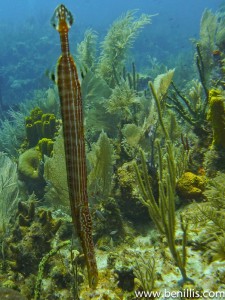
 The porous limestone bedrock of all three islands allows rainwater to filter through and out to sea at some depth, with no obvious water run off to speak of. This means the sea surrounding the islands maintains its crystal-clear aquamarine colour whatever the weather and is one reason for the islands’ reputation as one of the world’s best dive sites. Another is the well policed conservation policy on all reefs around all three islands, as well as, of course, year-round warm water and over 250 separate dive sites, including world-famous wrecks and coral walls. The clarity of water and predictability of conditions also make Cayman an ideal location for novice divers. Learning to dive isn’t what it was: the days of devoting long chunks of your holiday to the classroom are long gone. These days, the theory is done online prior to your trip, with practical skills easily mastered in a couple of sessions at your local pool. I trained with Oyster Diving (www.oysterdiving.com), who provide an excellent and highly professional service at multiple locations across the South of England. Once you’ve mastered the basics, you are referred to any local dive center at the destination of your choice – most Cayman hotels either have on-site dive centres or an arrangement with someone nearby – and, after your four qualifying dives in the open sea (witnessed, if my experience is anything to go by, by a profusion of turtles and groupers and the like), your certification is in your hand.
The porous limestone bedrock of all three islands allows rainwater to filter through and out to sea at some depth, with no obvious water run off to speak of. This means the sea surrounding the islands maintains its crystal-clear aquamarine colour whatever the weather and is one reason for the islands’ reputation as one of the world’s best dive sites. Another is the well policed conservation policy on all reefs around all three islands, as well as, of course, year-round warm water and over 250 separate dive sites, including world-famous wrecks and coral walls. The clarity of water and predictability of conditions also make Cayman an ideal location for novice divers. Learning to dive isn’t what it was: the days of devoting long chunks of your holiday to the classroom are long gone. These days, the theory is done online prior to your trip, with practical skills easily mastered in a couple of sessions at your local pool. I trained with Oyster Diving (www.oysterdiving.com), who provide an excellent and highly professional service at multiple locations across the South of England. Once you’ve mastered the basics, you are referred to any local dive center at the destination of your choice – most Cayman hotels either have on-site dive centres or an arrangement with someone nearby – and, after your four qualifying dives in the open sea (witnessed, if my experience is anything to go by, by a profusion of turtles and groupers and the like), your certification is in your hand.
But what of life above the water line? Cayman’s remote location makes it a great stopping point for many migrant birds (accounting for 80% of records) and is also home to 17 endemic bird sub-species and several notable regional endemics. Birds aside, the islands’ unique flora, butterflies and reptiles alone make it worth a visit. Much of the island’s fauna has evolved relatively unmolested and so even rarities are generally easily spotted. The diversity of flora is also extremely rich, with many plants bearing colorful local names: the red birch is known as the Tourist Tree, because its ‘skin’ turns red and peels. A caper plant producing gory looking bone-white fruit in a blood-red pod is known as Bloody Head Raw Bones.
Grand Cayman, with a permanent population of 50,000, is far and away the most developed island and easily earns its first world Caribbean reputation. George Town and its suburbs spread to the north and west and are filled with high end shopping and dining, much of which centers around the new Camana Bay development. Head to the extremities of the island, however, and its wilder side is quickly revealed. West Bay is dominated by the (actually 5.5 mile long) pristine, white sand Seven Mile Beach. At the north-eastern most end of West Bay is Barker’s National Park, home to a good variety of bird species, as well as a favorite destination for horse-riding, where you can have the unforgettable experience of riding a horse out to sea and swimming on horseback (info@ponies.ky). In West Bay itself, the friendly and relaxed Cobalt Coast Dive Resort has partnered up with Divetech, offering excellent diving at two locations – one eastward facing and one westward, both of which, uniquely among GC’s dive locations, have direct shore access to the outer edge of the reef. The dual locations allow for comfortable shore diving, even when wind is kicking up some swell.
Across to the east is much wilder. A coastal road encircles the landmass, while the interior is dominated by mangrove swamp and low-lying limestone outcrops. Around the swamp lie a series of high salinity ponds, home to an array of bird-life, including large flocks of Tricolored Herons, many unusual migrant shore-birds and the occasional Roseate Spoonbill. Groups of Antillean Nighthawks congregate here in summer too, gorging themselves on crepuscular insects. Also in the east are the Royal Botanical Gardens, home to Cayman’s most emblemic species, the Blue Iguana.
While it is the most well-known, the Blue is not the only endemic blue reptile here, with the delicate forest-dwelling Blue-Throated Anole also widespread. The beautifully planted Gardens contain habitats representative of all three islands and are home also to many of the islands’ endemic bird sub-species, including Loggerhead Kingbird, Caribbean Elaenia and Cuban Bullfinch.
To the west of the Botanical Gardens lies the Mastic Trail. The two-mile Trail, named for the critically endangered Yellow Mastic tree that lies along its path, crosses through 2 million year old woodland and is home to some 180 species of bird, including the endemic Grand Cayman Parrot. Other gems to look out for include the West Indian Woodpecker, Western Spindalis, Northern Flicker and Caribbean Ground Dove. The trail takes around three hours to hike and is easy-going underfoot, taking in a vast array of flora, many of which are endemics, with new species being discovered year after year. The butterfly diversity is also astonishing, with the world’s smallest – the pygmy blue – rediscovered here in 2002 having long been presumed extinct. It’s a treat to encounter such an easily accessible location for so many significant species.
Flying over to the Sister Islands is a dramatic affair, with stunning aerial views of azure seas and coral reef. Cayman Brac is the most ‘Old Caribbean’ of the islands, with a permanent population of 2,500, living largely in traditionally built houses. It’s very quiet and very pretty. The island is dominated by a rocky bluff, which forms a spine through the center of the eastern half of the island, ending in dramatic cliffs where Brown Boobies and Magnificent Frigatebirds nest. A large reserve cuts across the bluff to protect the Cayman Brac Parrot, easily spotted despite there being only an estimated 350 individuals left in the wild. There is an impressive wooden walkway across the reserve, allowing you to view the dense vegetation and rocky limestone beneath, without having to hack your way through it, and from which you can easily see two other delightful endemics: the Vitelline Warbler and the Red-Legged Thrush. Tucked into the side of the bluff are several caves, home to roosts of Jamaican Fruit Bat. The flat, western half of the island is characterized by more brackish pools, which support a large population of regional endemic West-Indian Whistling Ducks, among many other species of water-bird.

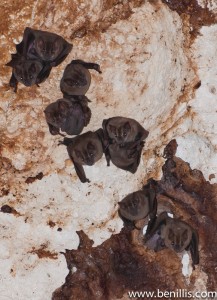 A short-hop across to Little Cayman and there is another significant iguana to track down. The Sister Islands Rock Iguana is still considered the same species as the Cuban, however momentum is gaining to declare this another endemic sub-species. Certainly the Rocks look very different from their more widespread Cuban cousin. Again, high salinity ponds line the island’s coast and one of these – The Booby Pond – is home to the Caribbean’s largest breeding population of Red-Footed Boobies, in both pale and dark morph, as well as more Magnificent Frigatebirds, Yellow-Crowned Night Heron and Double-Crested Cormorant. With a permanent population of just 250, Little Cayman is also one of the most unspoilt islands of the Caribbean. You are often alone on its long, white beaches and it’s a fantastic place to get away. The Pirate’s Point Resort has earned its reputation as a stand-out dive resort with exquisite food and a uniquely eccentric style. No surprise then that the bulk of guests return. Little Cayman diving is also, for my money, the most spectacular of the Caymanian lot, with the justly famous Bloody Bay Wall taking the well-deserved crown.
A short-hop across to Little Cayman and there is another significant iguana to track down. The Sister Islands Rock Iguana is still considered the same species as the Cuban, however momentum is gaining to declare this another endemic sub-species. Certainly the Rocks look very different from their more widespread Cuban cousin. Again, high salinity ponds line the island’s coast and one of these – The Booby Pond – is home to the Caribbean’s largest breeding population of Red-Footed Boobies, in both pale and dark morph, as well as more Magnificent Frigatebirds, Yellow-Crowned Night Heron and Double-Crested Cormorant. With a permanent population of just 250, Little Cayman is also one of the most unspoilt islands of the Caribbean. You are often alone on its long, white beaches and it’s a fantastic place to get away. The Pirate’s Point Resort has earned its reputation as a stand-out dive resort with exquisite food and a uniquely eccentric style. No surprise then that the bulk of guests return. Little Cayman diving is also, for my money, the most spectacular of the Caymanian lot, with the justly famous Bloody Bay Wall taking the well-deserved crown.
There’s a great deal to Cayman that belies its preppy, international banking reputation. The Cayman Islands Tourist Board offers free guided tours on all islands to any visitor and knowledgeable private guides are available to take things further. With well-established volunteer programs helping to protect everything from plants to turtles, via iguanas and butterflies, it’s also a place where it’s easy to get involved yourself and see your tourist dollar make the difference it so easily can.
Swimming with Stingrays
A century or so ago Cayman was plagued with mosquitoes and the island’s fishermen would stop on the sand-bar that encloses the north sound to gut their catch and clean their nets in the waist deep turquoise waters, so as not to be eaten alive back home. Over time, large groups of Southern Stingray would congregate in search of an easy meal and thus was Stingray City born. Stingrays are cartilaginous fish, closely related to sharks. They have a barb on their tail, which contains venom glands which can be released as a defense mechanism, causing a painful – and in the case of a very few species, even lethal – sting. For all their fearsome reputation, they are a docile and inquisitive fish, known for brushing their fins against new objects (and people) and ‘sniffing’ at them with their blunt noses, where their sensory organs are concentrated. Naturally, they feed on molluscs and crustaceans, which they sniff out in the sand and ingest with the powerful suction of their toothless mouths, although they do also take carrion. Five years ago, a spate of ill-informed newspaper articles implied that the rays were in some way coerced into playing and that this encouragement of an unnatural behavior pattern was detrimental to their health. The truth is all Stingray City excursions are licensed; feeding the rays is outlawed and the behavior of tourists and tour operators alike is tightly controlled. Yet still the rays turn out in their droves, apparently for nothing more than to play. Being marauded by a fish like a vast, tailed portobello mushroom is an exhilarating experience and a worthy addition to anyone’s wildlife bucket list. The sand-bar does get busy when the day-boats arrive, so for a more intimate encounter, get out before 11am or later in the afternoon.
Licensed to Cull
Beautiful and deadly, the invasive lionfish, venomous aquatic pet choice of any James Bond villain worth his salt, is both a ruthless predator and highly efficient breeder. Native to the Indo-Pacific, it was once thought that the lionfish was first introduced into Caribbean waters in the wake of Hurricane Andrew in 1992, when a south Florida aquarium was destroyed and six individuals escaped. A more recent report suggests it was around ahead of that, lending credence to the theory that its colonization of the region is thanks to specimens outgrowing private aquaria and being released by thoughtless tank owners. In any case, it is now widespread across the region and, due to a lack of predation by native species; a high tolerance for temperature variance; year-round breeding and the fact it reaches sexual maturity relatively young, it’s proving a significant problem. While native fish leave it unmolested, the lionfish gorges itself on their sexually immature young, meaning a deficit of sexually mature individuals and a bleak outlook for the natives. The Little Cayman-based Central Caribbean Marine Institute is one of many organizations across the region that are behind a dedicated regional culling program, which has been shown to have a great beneficial effect. Put simply: culling works. Divers and fishermen are given a brief lecture on the history of the invasion and the fish’s habits, as well as important advice on how to manage its extremely painful sting (plunge the affected region into water as hot as you can bear, as heat destroys the proteins that make up the venom). Once licensed, cullers are free to spear and remove fish even from protected areas. The second prong to this successful attack is to raise the fish’s profile on restaurant menus across the region. The lionfish is great eating and makes for an excellent alternative to often over-fished native species, such as snapper and grouper. So, if you don’t want blood on your hands or, as was the case for me, you fail to find any once you get licensed, be sure and order the lionfish ceviche when you get home.
Cayman Islands – What you need to know
Cost rating:
2,100 for ten days, excluding some meals and drinks
Sample package tour:
- Oyster Diving offer a ten day package to all three islands, including return economy flights from London to Grand Cayman. Package includes:
- 5 nights self-catering at Compass Point (apartments), Grand Cayman including 4 days diving and car rental
- 3 nights at Pirates Point Resort, Little Cayman including 3 meals per day, some drinks, 2 days diving and a deluxe room
- 2 nights at Brac Reef Resort, Cayman Brac including 1 day diving and all meals
- Internal flights from Grand Cayman > Little Cayman > Cayman Brac > Grand Cayman. Transfers to/from hotels.
The cost based on 2 people sharing is from £2,100 per person (£350 discount for non-divers). Oyster Diving also offer a free Scuba Review (refresher course) or trial dive for non-divers on all bookings.
How to get there:
BA flies directly to Grand Cayman via Nassau 4 times a week. Cayman Airways operates several daily flights between Grand Cayman and the The Sister Islands.
Visa requirements from UK:
None.
Best time to go:
November to April. The British summer months are hotter and more humid, with occasional rain showers, which generally pass quickly. Although not on the main hurricane route, Cayman is rarely caught out.
Tips and Warnings:
Grand Cayman is very developed and has excellent pharmacies and other services. The Sister Islands are more basic though, so be prepared with any medical needs ahead of visiting. Good hiking shoes are essential, as is sun-screen, a good mosquito repellent and a hat. Divers should check in with their dive centre and bring necessary certification. Where they occur, hiking trails, such as the Mastic Trail, are clearly marked and well-cleared of any dangers. Avoid hiking off these trails as Cayman is home to several formidable species of plant, including the Maiden Plum and the Manchineel tree, both of whose sap causes painful blistering and, in the latter case, occasionally even blindness. All Caymanian guides are extremely well-versed in these plants and will delight you with horror stories as they teach you what to avoid. For more information visit www.caymanislands.co.uk. For expert advice or to book guides, the Cayman Islands Department of Tourism mans a UK helpline on +44 207 491 7771 or can be emailed on concierge@caymanislands.co.uk.
Huge thanks to www.caymanislands.ky – www.oysterdiving.com – www.cobaltcoast.com – www.divetech.com – www.ponies.ky – www.bracreef.com – www.piratespointresort.com – www.compasspoint.ky – www.redsailcayman.com
For more from Ben, visit www.benillis.com.
Gear News
Introducing the TR-80, IR-50 and CS-30 Regulators from DYNAMICNORD

Whether you are a beginner or a professional diver – with the three new main regulators from DYNAMICNORD, everyone will find their favourite regulator. They all look super stylish.
Excellent performance with the TR-80
Quality and performance are the be-all and end-all for regulators. It is not for nothing that the TR stands for Tec Reg. The innovative design of the TR-80 guarantees absolute reliability – even in ice-cold waters.

Perfect breathing effort at 0.8 J/l / certified for diving in waters below 10 degrees / structural design made of solid brass for best cold protection / membrane-compensated design with dry seal of the first stage / reduced exhalation effort thanks to optimized exhalation membrane and bubble deflector / adjustable Venturi (dive/predive) and adjustment knob for individual inhalation comfort / innovative design of the front cover prevents free-flow in strong currents or when diving with scooters / design made of sandblasted brass, matt chrome finish / 2 HP and 4 LP outlets / mouthpiece made of high-quality, anti-allergic silicone for maximum comfort.


Amazing underwater adventures with the IR-50
The IR-50 is the top regulator for advanced and experienced divers. Natural breathing is the essence of this regulator.

Ideal breathing effort at 0.8 J/l /certified for diving in waters below 10 degrees / compensated membrane / adjustable venturi (dive/predive) and adjustment knob for individual inhalation comfort/ outlet valve and deflector for minimum exhalation effort and reduction of bubbles on the face / design made of sandblasted brass, matt chrome finish / 2 HP and 4 NP outlets / mouthpiece made of high-quality, anti-allergic silicone for maximum comfort.


The Workhorse – our CS-30
For diving centres and diving beginners – the workhorse stands for strong construction, reliability and robustness. Perfect for your training.

Optimal breathing effort at 0.8 J/l /recommended for diving in waters above 10 degrees / non-compensated piston / adjustable venturi (dive/predive) / outlet valve and deflector for minimum exhalation effort and reduction of bubbles on the face / design made of sandblasted brass, matt chrome finish / 1 HP and 3 NP outlets / mouthpiece made of high-quality, anti-allergic silicone for maximum comfort.


Octopus OP-30
The OP-30 is the ideal addition to all DYNAMICNORD regulators. It is identical in construction to the CS-30.

The TR-80, IR-50, CS-30 (DIN & INT) regulators and the Octopus OP-30 are available from DYNAMICNORD dealers and in the online store.
DYNAMICNORD – Your Outdoor Companion.
Marine Life & Conservation
Paul Watson Released as Denmark Blocks Japan’s Extradition Bid

Renowned anti-whaling activist Paul Watson has been released from custody in Greenland after spending five months in detention. Denmark’s Justice Ministry rejected Japan’s request for his extradition, citing insufficient guarantees that his time already served in custody would be credited against any potential sentence.
The 74-year-old Canadian-American was arrested on July 21 in Nuuk, Greenland’s capital, when his ship docked to refuel. His arrest was based on a 2012 Japanese warrant related to a 2010 encounter in Antarctic waters. Japan alleged Watson obstructed operations and caused damage to a whaling research ship during efforts to disrupt illegal whaling. Watson has consistently denied these claims, maintaining his commitment to marine conservation.
Denmark, which oversees extradition matters for Greenland, concluded that while the legal conditions for extradition were met, the lack of assurances from Japan regarding time-served credit made extradition untenable.
In a video shared by his foundation, Watson expressed gratitude and relief, saying, “After five months, it’s good to be out… and good to know they’re not sending me to Japan.” He added that the most difficult part of his time in custody was being separated from his two young sons.
Watson is a pioneering figure in marine conservation, known for founding the Captain Paul Watson Foundation in 2022 after decades of activism with the Sea Shepherd Conservation Society. His bold efforts to defend marine life have earned him widespread support, including from celebrities and conservationists. His work has also been featured in the acclaimed reality TV series Whale Wars.
Watson’s lawyer, Jonas Christoffersen, praised the decision, stating, “We are happy and relieved that Paul Watson is now free.” He added that Watson is eager to reunite with his family and continue his vital work.
The arrest occurred while Watson’s vessel, the M/Y John Paul DeJoria, was en route to the North Pacific with a team of 26 volunteers to intercept a Japanese whaling ship. His foundation described the arrest as politically motivated and emphasized that Watson’s actions were focused on ending illegal whaling practices.
Japan resumed commercial whaling in 2019 after leaving the International Whaling Commission, asserting that whale meat is a cultural tradition. Conservationists, however, continue to challenge these practices, highlighting their impact on marine ecosystems.
Despite the challenges, Watson remains steadfast in his mission to protect marine life and bring attention to whaling practices. His dedication to ocean conservation has made him a globally respected advocate for the environment.
-

 News2 months ago
News2 months agoIconic SS United States to become the World’s Largest Artificial Reef
-

 News3 months ago
News3 months agoBook Review – 52 Assignments: Underwater Photography
-

 Gear News3 months ago
Gear News3 months agoDYNAMICNORD – New German diving brand enters the British market
-

 News3 months ago
News3 months agoExploring Cenote El Pit: A Diver’s Dream
-

 Gear News3 months ago
Gear News3 months agoTry BARE drysuits (and maybe even win one!) this Friday with Sea & Sea at North West Dive Fest
-

 Marine Life & Conservation3 months ago
Marine Life & Conservation3 months agoBook Review: Coral Triangle Cameos
-

 Blogs2 months ago
Blogs2 months agoDive the Egyptian Red Sea this Autumn with Regaldive
-

 News3 months ago
News3 months ago2024 Ocean Art Underwater Photo Competition Announced


